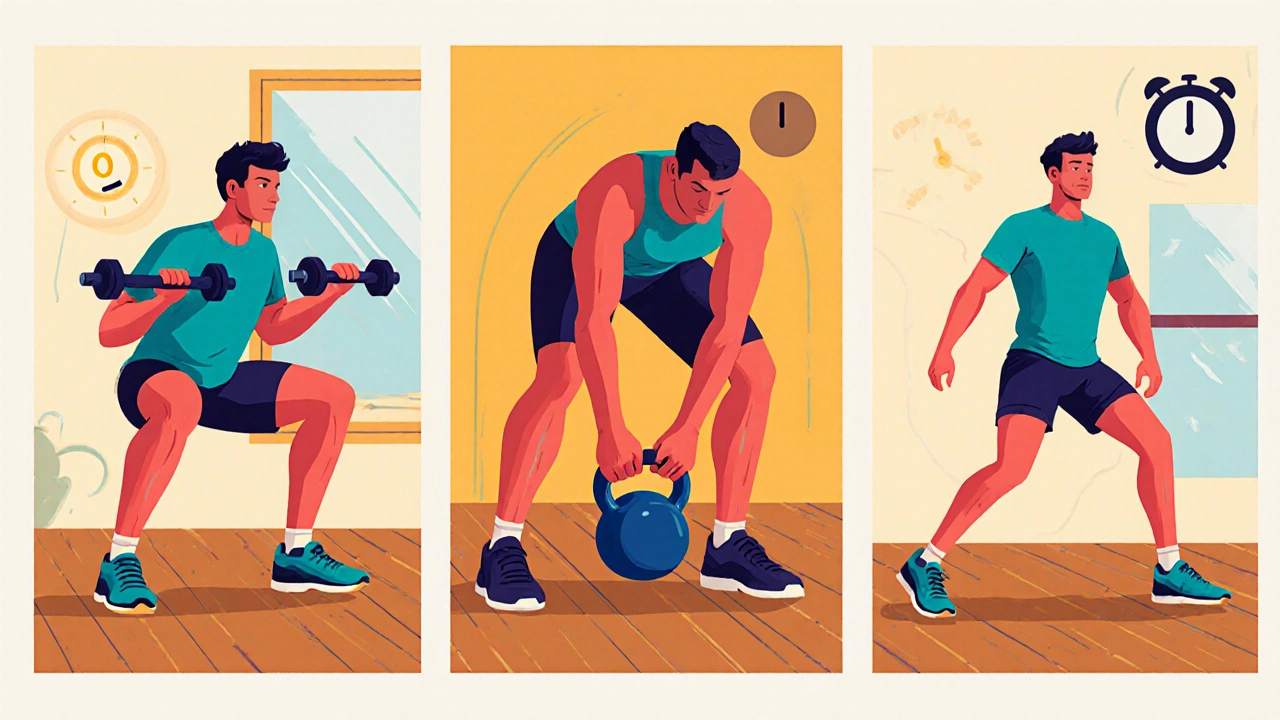4/30/10 Workout Timer
When you hear the phrase 4/30/10 method, you might picture a cryptic code. In reality, it's a straightforward, time‑efficient workout system that blends strength and cardio into a single session. 4/30/10 method is a fitness routine that consists of four rounds of 30 seconds of high‑intensity effort followed by 10 seconds of rest, repeated for a total of ten minutes. The idea is simple: push hard for a short burst, catch a quick breath, and keep the momentum going.
How the 4/30/10 Method Works
The name breaks down the structure:
- 4 - four complete rounds.
- 30 - thirty seconds of all‑out effort per exercise.
- 10 - ten seconds of rest before moving to the next move.
Each round features three different exercises targeting major muscle groups. For example, a beginner round might include bodyweight squats, push‑ups, and mountain climbers. After completing the three moves (90 seconds total), you rest for 30 seconds before starting the next round. By the end of the fourth round, you’ve spent about ten minutes working at a near‑maximal level.
Sample 4/30/10 Workout Schedule
Here’s a concrete example you can try at home with just a set of dumbbells:
- Round 1
- 30 s Dumbbell Goblet Squat
- 10 s Rest
- 30 s Dumbbell Bent‑Over Row
- 10 s Rest
- 30 s Burpees
- 30 s Rest (between rounds)
- Repeat the same three moves for Rounds 2, 3, and 4.
Adjust the weight or swap moves based on your fitness level. The key is to maintain intensity during each 30‑second burst.
Why Choose the 4/30/10 Method?
Fitness enthusiasts love this format for three main reasons:
- Time efficiency - Ten minutes of focused work can replace a 45‑minute conventional gym session.
- Cardiovascular boost - The short, high‑intensity intervals elevate heart rate into Zone 4 (80‑90% of max), improving VO₂ max.
- Strength gains - By selecting compound moves, you engage multiple muscle groups, promoting muscle hypertrophy when combined with progressive overload over weeks.
The method also taps into the psychological principle of “micro‑wins.” Completing a 30‑second sprint feels achievable, keeping motivation high throughout the whole workout.

4/30/10 vs. Other Popular Formats
| Feature | 4/30/10 Method | HIIT (Typical) | Tabata | Traditional Circuit |
|---|---|---|---|---|
| Duration | ≈10 min | 15‑30 min | 4 min (8 × 20 s) | 30‑60 min |
| Work‑Rest Ratio | 30 s : 10 s (3 : 1) | 20‑40 s : 20‑60 s (varies) | 20 s : 10 s (2 : 1) | Varies, often 30‑60 s per station |
| Equipment Needed | Optional dumbbells or bodyweight | Often cardio machines or weights | Usually bodyweight | Full gym setup |
| Primary Goal | Combined strength + cardio | Cardio and calorie burn | Maximal anaerobic power | Muscular endurance and strength |
| Suitability for Beginners | High (modifiable intensity) | Moderate | Low (very intense) | Low‑moderate |
As the table shows, the 4/30/10 method sits in a sweet spot: short enough for busy schedules, intense enough for measurable fitness gains, and flexible enough for beginners.
Getting Started: Equipment, Modifications, and Safety
All you truly need is a timer-your phone’s stopwatch works fine. If you have a pair of dumbbells (5‑15 kg), incorporate them for added resistance. For those without equipment, replace weighted moves with bodyweight equivalents: goblet squat → air squat, bent‑over row → reverse fly with resistance bands.
Safety tips:
- Warm‑up for 3‑5 minutes with dynamic stretches (leg swings, arm circles).
- Maintain proper form throughout each 30‑second burst; stop if you feel sharp pain.
- Keep the rest periods absolute-use a timer to avoid creeping over the 10‑second window.
- Stay hydrated; intense intervals elevate sweat loss quickly.

Tracking Progress: Metrics That Matter
Because the session is brief, you’ll want concrete data to see improvement. Here are three easy ways to measure progress:
- Heart‑rate zones: Aim to hit Zone 4 (80‑90% of max) during the work phases. A fitness tracker can alert you when you dip below the target.
- Repetition count: Record how many reps you complete in each 30‑second block. Over weeks, you should see a steady rise.
- Perceived exertion: Use the RPE scale (1‑10). If a round feels like a 7 now, aim for a 5 after two weeks of consistent training.
Combine these metrics with a simple log-paper or an app-to stay accountable.
Common Mistakes & How to Fix Them
Even a compact protocol can trip you up if you ignore a few details:
- Skipping the rest. The 10‑second pause isn’t optional; it lets your phosphocreatine system reload, preserving power for the next burst.
- Choosing overly complex moves. Simpler compound exercises let you maintain speed and intensity.
- Neglecting progression. After two weeks, increase weight, add a fourth exercise per round, or extend each work interval to 35 seconds.
- Bad timing. Use a dedicated interval timer app (e.g., Seconds Pro) to avoid manual counting errors.
Frequently Asked Questions
What fitness level is required for the 4/30/10 method?
The method is adaptable. Beginners start with bodyweight moves and longer rest periods; intermediate athletes add weight or more complex exercises.
How often should I perform the 4/30/10 workout?
Three sessions per week, spaced by at least one rest day, provides sufficient stimulus while allowing recovery.
Can I combine the 4/30/10 method with other training?
Yes. Pair it with steady‑state cardio on alternate days or with strength‑focused sessions (e.g., heavy squats) for a balanced program.
Do I need special equipment?
No. A timer and space to move are enough. Dumbbells, kettlebells, or resistance bands enhance the workout but aren’t mandatory.
How soon will I see results?
Most people notice improved stamina and a firmer core after 2‑3 weeks of consistent practice, with measurable strength gains in 6‑8 weeks.
Give the 4/30/10 method a try, track your numbers, and you’ll quickly see why it’s become a go‑to routine for busy fitness fans.
